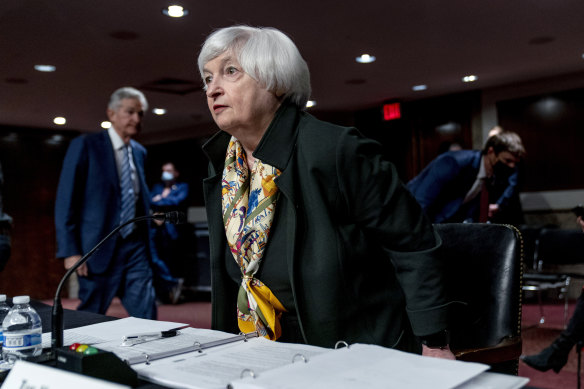Central bank digital currencies are the latest front in the culture wars
Save articles for later
Add articles to your saved list and come back to them any time.
It says something about the progress the development of digital bank currencies has made that they have now become a political issue in the United States.
Earlier this month, Florida’s governor (and likely Republican presidential candidate) Ron DeSantis, who has introduced legislation to ban the use of a federal digital currency in the state, claimed a central bank digital currency (CBDC) would be exploited by the Federal Reserve Board to “impose an ESG (environmental, social and governance) agenda”.
He said that the Fed could use the digital currency to stop Americans buying too much petrol, or preventing them from buying guns.
Not in my state! Florida’s governor (and likely Republican presidential candidate) Ron DeSantis has railed against the use of a central bank digital currency.Credit: AP
Congressional Republicans have even introduced bills seeking to prohibit the Fed from developing a direct-to-consumer, or retail model, for a CBDC because of their concerns that it could be used to create a kind of Orwellian, Big Brother-type comprehensive surveillance of the everyday finances of everyday Americans.
All that politicking is quite peculiar, given that both US Treasury Secretary Janet Yellen and Fed chair Jerome Powell have made it clear that – while considerable research is being undertaken on a US CBDC – they are not yet convinced that one is needed, or that the risks of introducing a digital currency outweigh the benefits.
Our Reserve Bank, which oversees one of the world’s more sophisticated payments systems, has a similar open-minded attitude to CBDCs. What problems would they solve? Could the apparently relatively modest potential gains in efficiency and competitiveness offset the risks?
Nevertheless, galvanised by the threat of privately issued digital currencies – most notably Facebook’s aborted attempt to create its own, as well as those being developed or already on issue from other governments – the world’s major central banks have accelerated their investigations and developments of their own CBDCs.
According to the Atlantic Council, 114 countries representing more than 95 per cent of global GDP are exploring a CBDC. All the G7 economies have moved from research to a development stage and 18 of the 20 G20 countries are at an advanced stage of development.
Eleven countries have actually launched a digital currency, with China’s pilot reaching 260 million people and set to expand to the entire country this year. China has also been trialling a cross-border platform for digital currencies with other countries in its region.
The sense of urgency and inevitability is evident, which makes the key challenges raised by the prospect of central bank-issued digital currencies starker – and more political.
Obvious concerns
The most obvious concerns from a central banker’s perspective are financial system stability and cybersecurity, given the chequered history of cryptocurrencies.
Both those involve technology and design solutions. Whether the CBDC operates on an account-based or token-based platform and whether it is available only at a wholesale level to banks and other institutions or is issued directly to individuals are vital issues, but there appears to be a range of options for dealing with them.
Most of the major central banks appear to be focusing on the less radical and less disruptive course of adopting a wholesale CBDC, where existing institutions would retain ownership of the customers and their data, and the existential threat existing intermediaries would face if they were cut out of the process by their central bank issuing currency directly to their customers would be reduced.
Both US Treasury Secretary Janet Yellen and Fed chair Jerome Powell have made it clear that they are not yet convinced a CBDC is needed.Credit: AP
The more sensitive and complex – and more political – of the issues the central banks confront in persuading politicians and communities of the benefits of CBDCs (assuming they themselves have been convinced) is the one that DeSantis and other Republicans have seized on.
Whether the CBDC is issued at a wholesale or retail level, there will be some centralised collection of transaction data that could be used to surveil private citizens’ financial transactions. In China, that would be a core appeal of the CBDC to its authorities. In Western democracies, privacy issues loom larger.
Government agencies in those democracies, of course, already collect and analyse a lot of individuals’ financial information. Anti-money laundering and anti-terrorism financing laws require banks and other financial institutions to identify suspect transactions and alert the authorities.
CBDCs, however, could take the collection of data to another level and, while there are tools that could be used to authenticate transactions in CBDCs while shielding the identity of those involved, that would be unacceptable to governments because of the potential for criminal activity.
Trade-offs and compromises
From the moment central bankers started taking digital currencies seriously, privacy issues were identified as a major stumbling block to the issuance of CBDCs because it was very clear that there would need to be trade-offs and compromises if privacy concerns and the risk that data could be used inappropriately by authorities were to be addressed.
Inevitably, there will be compromises. The European Union and others have suggested that there could be anonymity for lower-value payments, which couldn’t be seen by the central bank or anyone not identified by the user, with higher-value transactions subjected to the existing thresholds for anti-money-laundering and terrorist financing checks.
In other words, while the technology underlying the payments system might have changed radically, and CBDC’s substituted (albeit not entirely) for cash that carries inherent anonymity, from the users’ perspective not that much would change.
Banks can and do monitor their customers’ transactions in real time today. They can and are required to hand over information to the authorities if they see suspicious activity. There are, however – and would be in a CBDC environment – legal and regulatory protections to balance individual privacy rights and the authorities’ desire for a level of transparency.
In well-functioning democracies like Australia, the UK, Western Europe and (most of the time) America, those protections would be legislated and policed. Indeed, a CBDC couldn’t be issued here, the UK or in the US without legislation.
The privacy concerns about CBDCs in well-functioning democracies are probably over-blown when viewed against the intrusions already faced by consumers, whose financial transactions are not only available to their banks and other financial institutions but increasingly to social media and e-commerce companies.
In most of the jurisdictions considering CBDCs, the debates about their design have been left to the central banks and those in the community with a particular interest in digital assets and currencies, which isn’t surprising given the technological complexities and the as-yet inconclusive nature of the discussion of the values, like privacy, that will have to be incorporated into what’s essentially a completely new payments system architecture.
It hasn’t been something that has sparked much broader or more populist discussion, at least until very recently in America. As we move from theoretical discussions of CBDCs to their issuance by the major central banks, however, that could change quite quickly – particularly if it gets caught up in the identity and values battles that rage within the Anglosphere.
The Business Briefing newsletter delivers major stories, exclusive coverage and expert opinion. Sign up to get it every weekday morning.
Most Viewed in Business
From our partners
Source: Read Full Article




